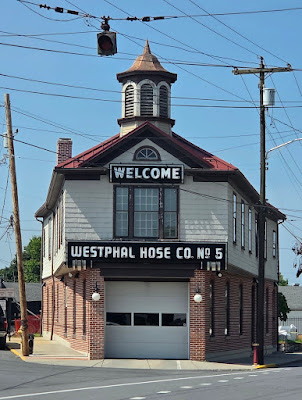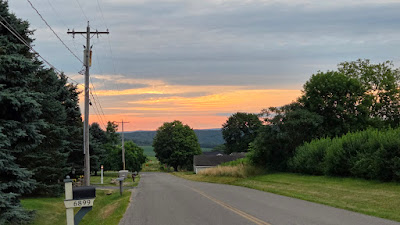It's Wednesday July 23rd, day 83 of our 2025 summer adventure. We departed the Loves RV Stop early, as we had a longer drive today. As we were getting hooked up, the barking coming from the dog park was obnoxious.
I glanced over and could not believe what I saw. I am sure they were transporting rescue dogs somewhere, but the cages stacked on top of each other screamed inhuman to me. I can only imagine what the sound in that van was like when they are driving down the road!
Route 11 parallels US 81. We prefer the two lane roads verses the interstates! It was a partially overcast morning as the sun was working hard to burn off the morning fog! I do love this eerie look!
Radford Virginia is formerly known as Lovely Mount, Central City, English Ferry and Ingle's Ferry. Now it is a recreation center for the New River Valley, hosting numerous tournaments and events every year. The Riverway is a signature hiking and biking trail in the region. The riverfront in Radford is highly utilized and serves as a point of pride for Radford as it is known as "The New River City."
Also in Radford is Radford University. It is well known for its strong faculty/student bonds, innovative use of technology in the learning environment and vibrant student life on a beautiful 211-acre classic campus, Radford University offers students many opportunities to get involved and succeed in and out of the classroom. Radford University offers 67 degree programs in 38 disciplines and two certificates at the undergraduate level; 22 master's programs.
We have been in Virginia for a while, but this is the first LOVE sign I have seen. Virginia Is For Lovers slogan was unveiled in 1969. Virginia is for Lovers is one of the most iconic and enduring tourism slogans in the world. Originally crafted to appeal to young travelers with interests in history, beaches, and outdoor adventures, the phrase quickly took on a broader meaning, symbolizing a love for all things Virginia.
Pulaski, VA was named for Count Casimir Pulaski, an exiled Polish nobleman who fought during the American Revolution as part of George Washington's army. Pulaski County has a rich history tied to early settlers, the industrial era, and railroads, as highlighted by the Raymond F. Ratcliffe Memorial Museum of Transportation. Pulaski County is known for its outdoor activities, with two of Virginia's most visited state parks: Claytor Lake State Park and New River Trail State Park. That would explain the pictures in this mural.
In Pulaski, we saw our second "Love" sign!
Draper Mountain is a mountain ridge in Pulaski County, Virginia. The area is named after John Draper, who, along with his family, settled there. The overlook has a historical marker telling the story of Draper and an abandoned building. The mountain road features an overlook with scenic views of the New River Valley and surrounding mountain ranges.
Route 11 goes onto Interstate 81 for a bit. We got off I-81 and got onto Hwy 52 into Fancy Gap. US Highway 52 runs through Fancy Gap, Virginia, and is a popular route for both locals and tourists.
It's known for its scenic beauty, especially as it winds through the Blue Ridge Mountains, and it's a direct route to attractions like the Blue Ridge Parkway. It's not for the faint of heart RV drivers! But, then Charlie always loves a challenge!
VA / NC border on Route 52 brings you into Mount Airy, NC. Route 52 is a two-lane mountain road entering NC at a 3,000-foot elevation from the north at the mountainous Fancy Gap, Virginia. Route 52 later becomes a four-lane roadway where it flows into the more level terrain from Andy Griffith's Mount Airy to Winston-Salem.
Route 52 intersected with Route 601. This route begins or ends in Mt Airy. I guess it is all about your perspective or if you are heading north or south! Mount Airy, North Carolina, is famously known as the real-life inspiration for the fictional town of Mayberry in the classic TV show, The Andy Griffith Show. Andy Griffith, who starred in the show, was a native of Mount Airy, and many of the show's locations and characters were based on his hometown and its residents.
We took I-85 to I-77 to get around Charlotte NC. We crossed the NC / SC border very close to our destination for the night, the Charlotte / Fort Mills KOA, Fort Mills SC.
It is a full hook-up site and set up was a breeze. We walked over to the local food truck at John's Place. It was a great place to hang out for a bit. Charlie got himself a nice ice cold beer!
Stay tuned for more #TwoLaneAdventures





.jpg)










.jpg)




















.jpg)



.jpg)










